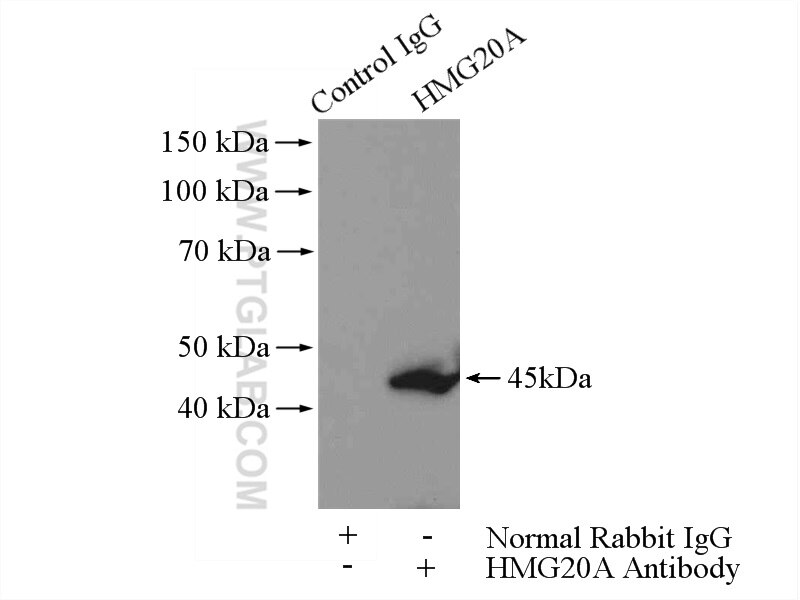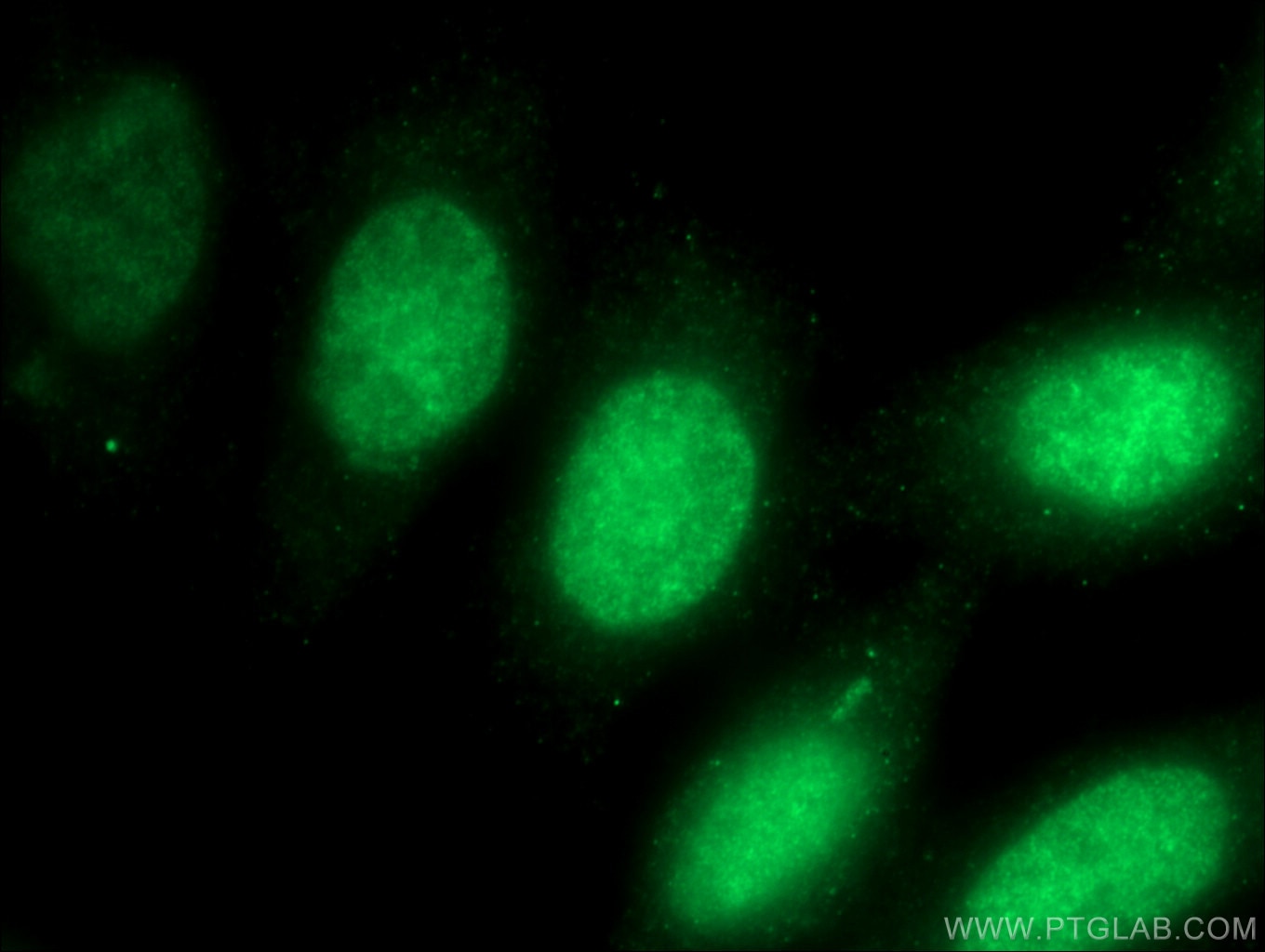Tested Applications
| Positive WB detected in | Jurkat cells, HEK-293 cells |
| Positive IP detected in | Jurkat cells |
| Positive IHC detected in | human pancreas cancer tissue Note: suggested antigen retrieval with TE buffer pH 9.0; (*) Alternatively, antigen retrieval may be performed with citrate buffer pH 6.0 |
| Positive IF/ICC detected in | HepG2 cells |
Recommended dilution
| Application | Dilution |
|---|---|
| Western Blot (WB) | WB : 1:500-1:2000 |
| Immunoprecipitation (IP) | IP : 0.5-4.0 ug for 1.0-3.0 mg of total protein lysate |
| Immunohistochemistry (IHC) | IHC : 1:20-1:200 |
| Immunofluorescence (IF)/ICC | IF/ICC : 1:50-1:500 |
| It is recommended that this reagent should be titrated in each testing system to obtain optimal results. | |
| Sample-dependent, Check data in validation data gallery. | |
Published Applications
| KD/KO | See 3 publications below |
| WB | See 10 publications below |
| IHC | See 2 publications below |
| IF | See 3 publications below |
| IP | See 2 publications below |
| CoIP | See 1 publications below |
Product Information
12085-2-AP targets HMG20A in WB, IHC, IF/ICC, IP, CoIP, ELISA applications and shows reactivity with human, mouse, rat samples.
| Tested Reactivity | human, mouse, rat |
| Cited Reactivity | human, mouse |
| Host / Isotype | Rabbit / IgG |
| Class | Polyclonal |
| Type | Antibody |
| Immunogen |
CatNo: Ag2718 Product name: Recombinant human HMG20A protein Source: e coli.-derived, PET28a Tag: 6*His Domain: 1-347 aa of BC021959 Sequence: MENLMTSSTLPPLFADEDGSKESNDLATTGLNHPEVPYSSGATSSTNNPEFVEDLSQGQLLQSESSNAAEGNEQRHEDEQRSKRGGWSKGRKRKKPLRDSNAPKSPLTGYVRFMNERREQLRAKRPEVPFPEITRMLGNEWSKLPPEEKQRYLDEADRDKERYMKELEQYQKTEAYKVFSRKTQDRQKGKSHRQDAARQATHDHEKETEVKERSVFDIPIFTEEFLNHSKAREAELRQLRKSNMEFEERNAALQKHVESMRTAVEKLEVDVIQERSRNTVLQQHLETLRQVLTSSFASMPLPGSGETPTVDTIDSYMNRLHSIILANPQDNENFIATVREVVNRLDR Predict reactive species |
| Full Name | high-mobility group 20A |
| Calculated Molecular Weight | 347 aa, 40 kDa |
| Observed Molecular Weight | 45-50 kDa |
| GenBank Accession Number | BC021959 |
| Gene Symbol | HMG20A |
| Gene ID (NCBI) | 10363 |
| RRID | AB_2117587 |
| Conjugate | Unconjugated |
| Form | Liquid |
| Purification Method | Antigen affinity purification |
| UNIPROT ID | Q9NP66 |
| Storage Buffer | PBS with 0.02% sodium azide and 50% glycerol, pH 7.3. |
| Storage Conditions | Store at -20°C. Stable for one year after shipment. Aliquoting is unnecessary for -20oC storage. 20ul sizes contain 0.1% BSA. |
Background Information
The HMG (high mobility group) proteins are nonhistone chromosomal proteins that is present in almost all eukaryotic cells, and it functions to stabilize nucleosome formation and acts as a transcription-factor-like protein that regulates the expression of several genes. HMG20A has a role in the initiation of neuronal differentiation by activating REST-responsive genes, and it also nvolves in the recruitment of the histone methyltransferase MLL and consequent increased methylation of histone H3 lysine 4. HMG20A (for inhibitor of BRAF35) overcomes the repressive effects of the neuronal silencer REST and activates REST-responsive genes through the modulation of histone methylation
Protocols
| Product Specific Protocols | |
|---|---|
| IF protocol for HMG20A antibody 12085-2-AP | Download protocol |
| IHC protocol for HMG20A antibody 12085-2-AP | Download protocol |
| IP protocol for HMG20A antibody 12085-2-AP | Download protocol |
| WB protocol for HMG20A antibody 12085-2-AP | Download protocol |
| Standard Protocols | |
|---|---|
| Click here to view our Standard Protocols |
Publications
| Species | Application | Title |
|---|---|---|
Nat Commun The H2A.Z and NuRD associated protein HMG20A controls early head and heart developmental transcription programs
| ||
Nat Commun KMT2A associates with PHF5A-PHF14-HMG20A-RAI1 subcomplex in pancreatic cancer stem cells and epigenetically regulates their characteristics | ||
EMBO Mol Med LSD1 inhibition induces differentiation and cell death in Merkel cell carcinoma. | ||
Cancer Cell Int Circular RNA ABCB10 promotes hepatocellular carcinoma progression by increasing HMG20A expression by sponging miR-670-3p. | ||
Biochim Biophys Acta Interactome of the inhibitory isoform of the nuclear transporter Importin 13. | ||
Biochim Biophys Acta The BRCA1-binding protein BRAP2 can act as a cytoplasmic retention factor for nuclear and nuclear envelope-localizing testicular proteins. |






















